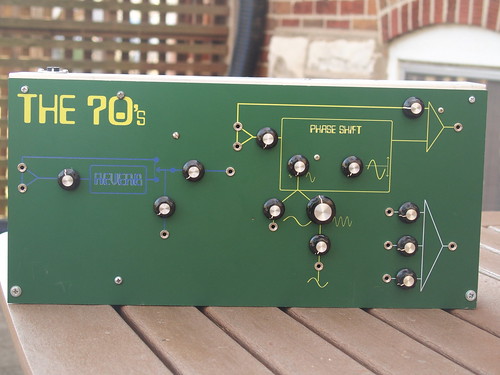The 70’s
This one is mostly for fun, but its sound is seriously lush. The name alludes to the fact that this is a frame for two very iconically 70’s sounding processors: a spring reverb and a Maestro Phase Shifter. The enclosure is 19 inches wide to accommodate a full-sized Hammond spring tank, and it’s metal, to shield this highly RF-sensitive device. The Maestro phase shifter circuit is a classic designed by none other than a then-young Tom Oberheim who went on to develop some of the biggest and lushest sounding analog synthesizers ever built. I added several control-voltage features to the phase shifter circuit but I was very careful to leave Oberheim’s beautifully designed audio signal path untouched by my uncouth butchery.
I had a lot of fun designing driver and recovery amplifiers for the venerable old Hammond spring-tank. (‘fun’ here is defined as what pasty overweight geeks who toil and obsess for weeks on-end in dim basements would call ‘fun’) The 1970-vintage tank was in amazingly excellent condition. They really DON”T build ’em like this anymore! And I even considered using a vintage 12AT7 vacuum tube driver design. But for one thing, I’m a tube-coward and didn’t trust myself to build all the high-voltage power-supply circuitry and deploy it all SAFELY in a metal box. And for another thing, I had already decided to call the gadget ‘The 70’s’, and in 1970, I was in 8th grade, habitually hanging around our neighborhood Radio Shack store, and transistors & ‘solid-state’ technology was all the rage back then. So I conveniently decided that a transistor-based amplifier design was ‘thematically consistent with my design goals’. [smirk]
And now in the 21st century even though we don’t have the flying cars that we were promised by Popular Mechanics magazine, we do have some power transistors that perform spectacularly well and efficiently. And it really was a bit of fun to home-in on a design that really rattled those springs!
This raises a point that is worth making in all these articles. While I don’t consider myself a craftsman by any stretch of the definition. There is one aspect of my approach of which I am actually proud. I design BY EAR. I never implement any circuit that I have not physically heard and in most cases, that I have not auditioned for hours during development. My work with long-form chaotic and turbulent analog designs can’t be assessed for their MUSICAL value unless I listen to how their output evolves over time. And in some cases that means a LOT of time. This makes my process utterly antithetical to any notion of commercial efficiency but it is the only method that guarantees that these uncouth and eccentric gizmos at least SOUND good. In the case of my simple reverb-tank I tried 9 different amplifier prototypes & combinations before I got the sound I really liked.
And finally, the box. I wanted to express the sort of exuberant stylistic folly of the 70’s, with it’s ‘avocado’-hued refrigerators. Put differently, I wanted this thing to be pretty ugly and ungainly. So I put the legends in the marvelously inscrutable MICR 13-B computer font, made the panel green, deployed period-accurate knobs, and used a deliberately low contrast blue for the reverb. (because I remember lots of 70’s guitar amps that were so poorly designed that their markings became invisible under stage lighting! Now THAT’s the 70’s I remember!

Comments are closed.